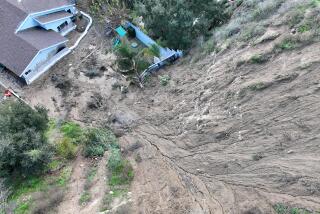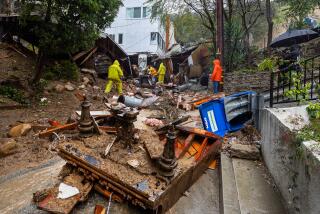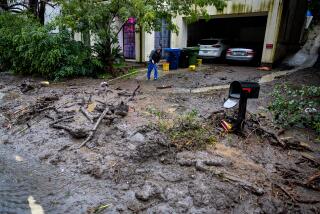San Joaquin River Endangers Towns as Crisis Builds
MENDOTA, Calif. â The placid San Joaquin River erupted in a rampage Saturday that burst through farm levees and threatened towns along its length as state disaster officials braced for new flooding.
Elsewhere in Northern California, the surging rivers that have forced evacuation of more than 100,000 people began to level off. But along the normally tranquil San Joaquin, the crisis may be just unfolding.
âItâs actually getting worse,â said Bill Draper, spokesman for the California Department of Water Resources. âItâs going to be a growing problem for days--four or five days.â
To the north, the city of Modesto was battling what state authorities called record flooding as the Tuolumne River, engorged by water rushing from the spillways at Don Pedro Reservoir, washed through the southern edge of the city. The river was 15 feet above flood stage.
President Clinton declared federal disasters in 37 California counties, opening the way for low-interest loans and other federal aid. Gov. Pete Wilson also has declared emergencies in the 37 counties, which permits state loans for rebuilding.
The Sacramento River and its tributaries remained at flood stage Saturday, but were mostly holding steady or starting to recede. Some people evacuated in the Yuba City area beside the Feather River were permitted to return to their homes.
The worst California flooding since 1986 has claimed four lives and caused an unknown but heavy amount of damage to homes, farmland, livestock and roads.
Ann Veneman, Wilsonâs agriculture secretary, toured the Central Valley on Saturday by helicopter, and said she was astounded by the loss.
âYou can see orchards under water, dairies under water,â Veneman said. âWe just donât know how long this water is going to stand. Itâs going to be very difficult in the short term to tell what kind of economic damageâ will result from the flooding.
Veneman said a major problem concerned livestock in flooded areas. Dairy farmers could not get to their herds to milk them. If cows arenât milked for more than 24 hours, their milk production stops and does not start again until they go through another calving cycle--a potentially huge loss.
Although the heavy storms had passed, and only minor showers were anticipated during the weekend, the impact of the New Yearâs week deluge continued to threaten. Rapid releases of water from reservoirs filling with storm runoff out of the Sierra Nevada were swelling rivers to dangerous levels, particularly the San Joaquin, which drains the fertile agricultural valley that carries its name.
âThat river is carrying far more than it can handle,â Draper said.
On Saturday, the San Joaquin, which collects the flow of the Kings, Tuolumne and other major rivers, threatened Mendota and other farming towns on the west side of the valley. Two major levee breaks flooded thousands of acres of fruit trees, grape vines and fallow crop land and inundated a dairy farm.
âWeâre going to see a lot more levee breaks, particularly along the San Joaquin,â Draper said.
Water leaving Friant Dam above Fresno takes roughly a week to flow past Mendota to the Sacramento-San Joaquin River Delta, Draper said, raising concerns that notoriously fragile delta levees could fail next.
In more normal weather, 98% of the San Joaquin is diverted for irrigation, and the Friant Dam releases about 9,000 cubic feet per second of water. But with Millerton Lake full behind the dam, the amount of water being freed has reached as much as 59,000 cubic feet a second, emergency officials said.
A levee breach on the north bank of the San Joaquin in Fresno County sent water gushing through cotton fields and almond groves--and would have swept away an elderly couple in a car had not an earthmoving machineâs driver come to their rescue.
The couple was trying to stay on the road between Firebaugh and Highway 99 when a surge of flood water slammed into the car and shoved it off the road.
As water rose around the marooned vehicle, the operator of a giant backhoe and tractor rig drove up, dipped the backhoe bucket to the side of the car, and the couple scrambled aboard. They were uninjured.
To combat flooding on the west side of the San Joaquin Valley, farmers tried for a time to relieve pressure on the breached levees by drawing off river water into a network of irrigation canals upstream.
But as a canal company employee watched the water rise late Saturday, he shook his head and said, âGod has taken over now. The canals canât help anymore because the water would only back up into the river.â
Along the San Joaquin River, farmers in heavy earthmoving equipment and workers in water up to their thighs tried to reinforce dikes and save their orchards.
âWeâve been trying to stop the breaks at each point,â said Kimberly Schaad, 20, trying to help save her familyâs 180-acre prune orchard. âThe crew works on one break and rushes to the other. Itâs like putting fingers in holes.â
In Mendota, authorities feared that the San Joaquin River might top its banks and rush into a sewage treatment plant. Inmates from nearby state prisons piled sandbags around the plant.
Mendota, a town of about 8,000 that calls itself the cantaloupe capital of the world, sits at a low point in the western side of the San Joaquin Valley. It is threatened by the San Joaquin River and by streams that empty from the east side of the Coastal Range.
But emergency crews were growing weary of the wait.
âThey were telling us it would be here 17 hours ago, then they said 8 hours, then two hours, and now the time has passed, and it still has not come. Weâre still waiting,â said firefighter Bernie Lozano of the Fresno County Fire Department.
In the San Joaquin River bottom near Fresno, the back nine of the Fig Garden Golf Course flooded, and residents of the exclusive housing development saw their swimming pools turn to mud baths.
At the home of Kevin and Linda Lester, a flagpole, usually on the side of the property, was standing in the middle of the river, and beavers could be seen reclaiming parts of the Lestersâ backyard.
âIn normal times, this is not much more than a glorified stream. This is a river today,â Linda Lester said.
In the Sacramento Valley, the cities of Marysville and Yuba City remained all but deserted during the day, with only emergency services workers on the eerily empty streets.
Lights were on in some businesses. But proprietors and customers were nowhere to be found. State and local authorities had ordered the 55,000 residents to leave Thursday night as a precaution.
âItâs just a ghost town out there,â said Bill Harris, a Yuba County probation officer who was pressed into service to help cope with the disaster. Looking out the front of the courthouse, Harris said: âAll you see is police patrolling.â
By late Saturday, with the levees containing the Yuba and Feather rivers, authorities decided to permit Yuba City residents, but not yet people from Marysville, to return to their homes.
âThe first thing Iâm going to do when I get home is hug the floor, because Iâm so glad to be back. Then Iâm going to take a shower,â said Yuba City teenager Wayne Osborne, who had spent two nights in an evacuation center.
Even as those levees held, however, a levee downstream that holds back Sacramento River water broke Saturday afternoon, forcing the evacuation of more than 300 people from the small town of Robbins.
In Modesto, a city of 180,000, the Tuolumne River was causing what state authorities called record flooding. The Tuolumne is one of the major rivers emptying runoff from the Sierra.
The Modesto flooding is striking hard at the south end of town, inundating roads and trailer parks.
At one swamped mobile home park, the only sign of life was search and rescue workers. They were in kayaks, paddling from trailer to trailer, responding to a report that a small girl had been trapped by the flood.
âWe pulled a few dogs out of there, but we didnât find a little girl,â said Matt Kimura, a raft guide who joined the search with 10 other volunteers.
After a three-hour search, the team gave up, assuming the report was in error.
More than 1,000 homes were flooded in Modesto, and 3,000 residents evacuated. The cityâs sewage treatment plant was knocked out of service, and in a less populated area to the west of the city, two levees broke, forcing farm families to evacuate.
âThe water is up to my back porch,â said Kim Rodriguez, 36, who sandbagged her Modesto home as the Tuolumne River rose from its usual bank, and washed 200 feet across a road to the rear of her home. âMy husband fishes there. The kids play in the river. We never thought it would flood like this.â
Times staff writers Mack Reed in Mendota, Carl Ingram in Yuba County, Max Vanzi and Dave Lesher in Sacramento and Bettina Boxall in Los Angeles contributed.
(BEGIN TEXT OF INFOBOX / INFOGRAPHIC)
New River Flooding
Levee breaks on Saturday inundated homes and farmland in Modesto and along the San Joaquin River. Concern was highest in Mendota and other towns beside the surging San Joaquin. The threat of new flooding could last for several days, state officials said.
More to Read
Sign up for Essential California
The most important California stories and recommendations in your inbox every morning.
You may occasionally receive promotional content from the Los Angeles Times.










